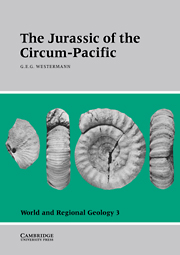Book contents
- Frontmatter
- Contents
- List of contributors
- Preface
- Acknowledgments
- Introduction
- Part I Time scales
- Part II Circum-Pacific base map
- Part III Regional geology and stratigraphy
- 4 Western Canada and United States
- 5 Meso-America
- 6 Western South America and Antarctica
- 7 Australasia
- 8 Indonesia and Papua New Guinea
- 9 Southeast Asia and Japan
- 10 Eastern China
- 11 Eastern Russia
- Part IV Biochronology
- Part V Biogeography
- Part VI Climatology and oceanography
- Appendix: Biochronology and atlas with index and guide fossils
- General Index
- Index of Guide- and Indexfossils
8 - Indonesia and Papua New Guinea
Published online by Cambridge University Press: 04 August 2010
- Frontmatter
- Contents
- List of contributors
- Preface
- Acknowledgments
- Introduction
- Part I Time scales
- Part II Circum-Pacific base map
- Part III Regional geology and stratigraphy
- 4 Western Canada and United States
- 5 Meso-America
- 6 Western South America and Antarctica
- 7 Australasia
- 8 Indonesia and Papua New Guinea
- 9 Southeast Asia and Japan
- 10 Eastern China
- 11 Eastern Russia
- Part IV Biochronology
- Part V Biogeography
- Part VI Climatology and oceanography
- Appendix: Biochronology and atlas with index and guide fossils
- General Index
- Index of Guide- and Indexfossils
Summary
INDONESIA
Introduction: tectonics and Jurassic outcrops
The Indonesian Archipelago represents a convergence between three megaplates: Eurasian, Indoaustralian, and Pacific. The three megaplates have moved against each other since Late Triassic time and are at present still moving, so that the Indonesian region belongs to a highly mobile zone. Consequently, this region has one of the most complex geomorphologic and geologic development patterns in the world. The archipelago at present has two stable plates, Sunda and Sahul, which are intertwined by island arcs, magmatic arcs, and subduction trenches, whereby lateral faults are interrupting the regular form of the arcs (Figure 8.1).
This complex region is the result of combined development of arc-trench systems, accretions, and collisions initiated by movement of the megaplates. The three tectonic regimes are represented by accreted terranes, arc–microplate collisions, arc–continent collisions, and arc–arc collisions. Northwestern Indonesia, including west Sulawesi, is part of the Eurasian plate, whereas southern and eastern Indonesia and all of Irianjaya belong to the Indoaustralian plate.
The basement of the sedimentary basins consists of continental and oceanic terranes of incompletely known ages. Radiometric ages for metamorphic and mafic basement rocks are limited and become unreliable for older epochs because of alteration and repeated metamorphism by tectonic events. The most acceptable dating for those rocks is therefore based on their stratic positions relative to fossil-bearing beds. Biostratigraphy is therefore very important in terrane analysis.
Figure 8.2 shows the Jurassic outcrops of Indonesia, numbered as in the descriptions and in Figure 8.3.
- Type
- Chapter
- Information
- The Jurassic of the Circum-Pacific , pp. 181 - 193Publisher: Cambridge University PressPrint publication year: 1993
- 8
- Cited by



